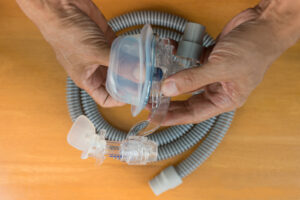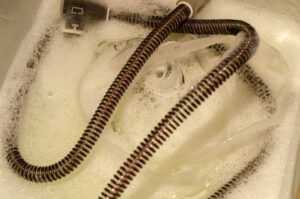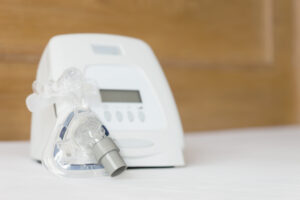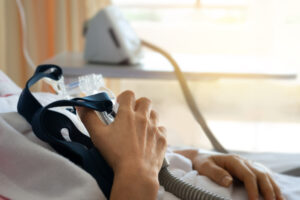Continuous positive airway pressure (CPAP) therapy is the most effective treatment available for obstructive sleep apnea. People with sleep apnea experience frequent lapses in breathing as they sleep. This can lead to poor sleep and daytime sleepiness.
A CPAP machine helps keep the upper airway open by pumping pressurized air through a CPAP mask that seals around part of the face. But it can be challenging to sleep comfortably in a CPAP mask, especially for side sleepers.
Side sleeping is one of the most common sleep positions among adults and may actually help improve sleep quality for those with sleep apnea. However, side sleeping can pose some unique obstacles for CPAP therapy.
We’ll discuss the challenges side sleepers face, choosing the right CPAP mask, and working closely with a doctor or sleep specialist to promote successful CPAP treatment.
Shop the Best CPAP MasksWhat Are the Challenges of CPAP for Side Sleepers?
Side sleepers face several challenges when it comes to sleeping comfortably in their CPAP masks.
- Mask type: Side sleepers should carefully consider what type of CPAP mask is best for their sleep style. Generally, people who sleep on their side do best with masks that are compact and flexible to allow for movement and less contact with the face. Bulkier masks such as the full-face style are usually not as comfortable for side sleepers.
- Mask seal: CPAP therapy relies on an air-tight seal between the mask and the face to deliver pressurized air and keep the airway open. Air leaks are a common issue among CPAP users and usually result from a poorly fitted mask. Side sleeping increases the risk of air leaks.
- Mask moving during sleep: Many people who mostly sleep on their sides will switch between several positions throughout the night. This can cause the mask to move during sleep and may lead to air leaks.
- Mask pressing on the cheek: When side sleeping, one side of the face usually rests on the pillow or sleep surface. This position presses the CPAP against the cheek and can create painful pressure points.
CPAP mask issues have a significant impact on comfort and can interfere with the treatment’s effectiveness. If CPAP therapy feels uncomfortable and ineffective, a person is less likely to continue with treatment. That’s why it’s important for side sleepers to find a comfortable mask that fits well and works for their sleep position.
What Types of CPAP Masks Are Best for Side Sleeping?
The best types of CPAP masks for side sleepers are the nasal pillow and nasal mask styles. But the right mask also depends on an individual’s personal preferences. Side sleepers need a CPAP mask that minimizes the challenges they face, such as changing sides throughout the night and having their face pressed against their pillow or sleep surface.
To meet these challenges, side sleepers tend to do best with a mask that is flexible and has a small footprint. Nasal pillow and nasal CPAP masks are generally good fits for side sleepers, since they offer a balance between comfort and functionality.
It’s important to work with a doctor or sleep specialist and try a wide range of masks to find the style, model, and size that works best. Each side sleeper is likely to have their own comfort preferences to fit their unique facial shape. Experts agree that the best CPAP mask is the one a person is willing to use.
Nasal Pillow Masks
Nasal pillow masks are some of the most compact CPAP masks available. They consist of a soft, silicone pillow that sits just below the nose and fits into the nostrils to create a seal.
This style of CPAP mask is an excellent option for side sleepers. Nasal pillow masks are lightweight with a minimal footprint and can withstand the frequent movement of active sleepers. Their minimal design also makes nasal pillows a good choice for people who like to read or watch TV in bed before falling asleep.
Nasal pillow masks may not be appropriate for all side sleepers. These masks can be uncomfortable at pressure settings of 12 cm H2O or more. People with chronic nasal issues, such as a deviated septum or severe congestion, may do better with a different type of CPAP mask.
Nasal Masks
A nasal mask is a popular CPAP mask style that fits over the nose. These masks typically create a seal around the bridge of the nose and upper lip, but some models are more compact.
Nasal masks tend to work better at higher pressure settings than nasal pillow masks. As a result, nasal masks offer a good balance for side sleepers looking for a less bulky mask that can handle higher pressures. There are also many different models and sizes to choose from, making it easy to find a nasal mask that fits well.
Keep in mind that nasal masks have some of the same downsides as nasal pillow masks. For example, nasal masks may not work well for side sleepers with nasal issues.
Other Mask Types
Nasal pillow and nasal CPAP masks are good choices for side sleepers, but several other styles may be worth considering. These include full-face masks that cover the mouth and nose and oral masks that only cover the mouth.
Full-face masks create a seal and deliver pressurized air to both the nose and the mouth. This style of mask is very common but tends to be bulkier than nasal pillow and nasal masks. However, full-face masks can work well for side sleepers who need a higher pressure setting or breathe through their nose.
Oral masks create a seal and deliver air only to the mouth. Doctors rarely prescribe oral masks and not many models are available. But they can work well for people with chronic nasal problems.
What Else Can Help Side Sleepers Use a CPAP?
Aside from your mask choice, you can use a variety of accessories and strategies to ensure your CPAP therapy is comfortable and effective. Don’t forget to talk with your doctor or sleep specialist for individualized guidance. This is especially crucial in the first days and weeks of your CPAP therapy when you’re still getting used to your CPAP treatment.
Give Yourself Time to Acclimate
It’s natural to feel intimidated by CPAP therapy or worry that the treatment will be uncomfortable. Understand that it can take time to find a comfortable set-up that works for you. Be patient with yourself and allow plenty of time to adapt to your new CPAP treatment.
Health experts recommend setting yourself up for success with an initial adjustment period. Before jumping into sleeping with your mask on, practice taking your mask on and off and wearing it while awake. This will help you get used to wearing your mask and the feeling of pressure from your CPAP machine.
If you find the sensation of pressure too uncomfortable, talk with your doctor. Some CPAP machines have a pressure ramp option. A pressure ramp begins at a low pressure setting and slowly increases pressure over a period of time, making it easier to fall asleep.
Even if you’ve been using CPAP for a while, don’t hesitate to reach out to your doctor for help. Factors such as weight change may require mask resizing or adjustments to your pressure settings. However, don’t try to change the pressure settings on your CPAP machine without your doctor’s guidance. Only use the pressure settings recommended by your provider.
Prevent Mouth Leaks
A poorly fitting mask is a common cause for leaks, but even with a well-fitting mask, you may still experience air leaks if you breathe through your mouth. Mouth leaks can prevent your CPAP machine from delivering the right level of pressure into your airways.
Nasal pillow and nasal CPAP masks can be ideal for side sleepers, but these styles of masks don’t cover the mouth. If you tend to breathe through your mouth while you sleep, the pressurized air can easily escape before it has a chance to reach your upper airway.
It can be hard to know how you breathe while you sleep. If you sleep with a partner, ask them whether you breathe through your mouth when you sleep on your side with your CPAP mask. Dryness in the mouth when you wake up can be another sign of a mouth air leak.
To address mouth leaks while sleeping on your side, you can pair your nasal pillow or nasal mask with a chin strap. A chin strap helps hold your mouth closed to encourage nasal breathing and prevent mouth leaks. If a chin strap doesn’t work, consider using a full-face mask that covers both your nose and your mouth.
Address Dryness and Congestion
Nasal pillows and nasal masks have a good mix of features for side sleepers, but the pressurized air can cause or worsen pre-existing nasal dryness and congestion. CPAP users are especially susceptible to dryness during the cold winter months or if they live in a dry climate like the southwestern United States.
For side sleepers experiencing nasal dryness, health experts recommend using a heated CPAP humidifier. Many CPAP humidifiers on the market allow for customized temperatures. Users may need to experiment to find the most comfortable humidity and heat settings for their needs.
Nasal congestion is another common problem that can make it harder to breathe comfortably during CPAP therapy. For some people, medications such as topical or oral antihistamines can help relieve overnight congestion. Side sleepers with more severe nasal congestion may require a full-face mask instead of a nasal pillow or nasal CPAP mask.
Avoid Tangled Equipment
Active side sleepers may find themselves getting tangled in their CPAP tubing when they change positions or move around in their sleep. Most people, including side sleepers, change positions every hour or so as they sleep.
For active sleepers as well as side sleepers, a hose suspension system may be helpful. This CPAP accessory holds the CPAP tubing above the bed and away from the body, helping to prevent snags and tangles.
References
Get Your Sleep Questions Answered Live on 4/30
Have questions about sleep? Get all your sleep-related questions answered in a Live Q&A on YouTube with renowned sleep expert Dr. Michael Breus at 5 p.m. PST/8 p.m. EST.











